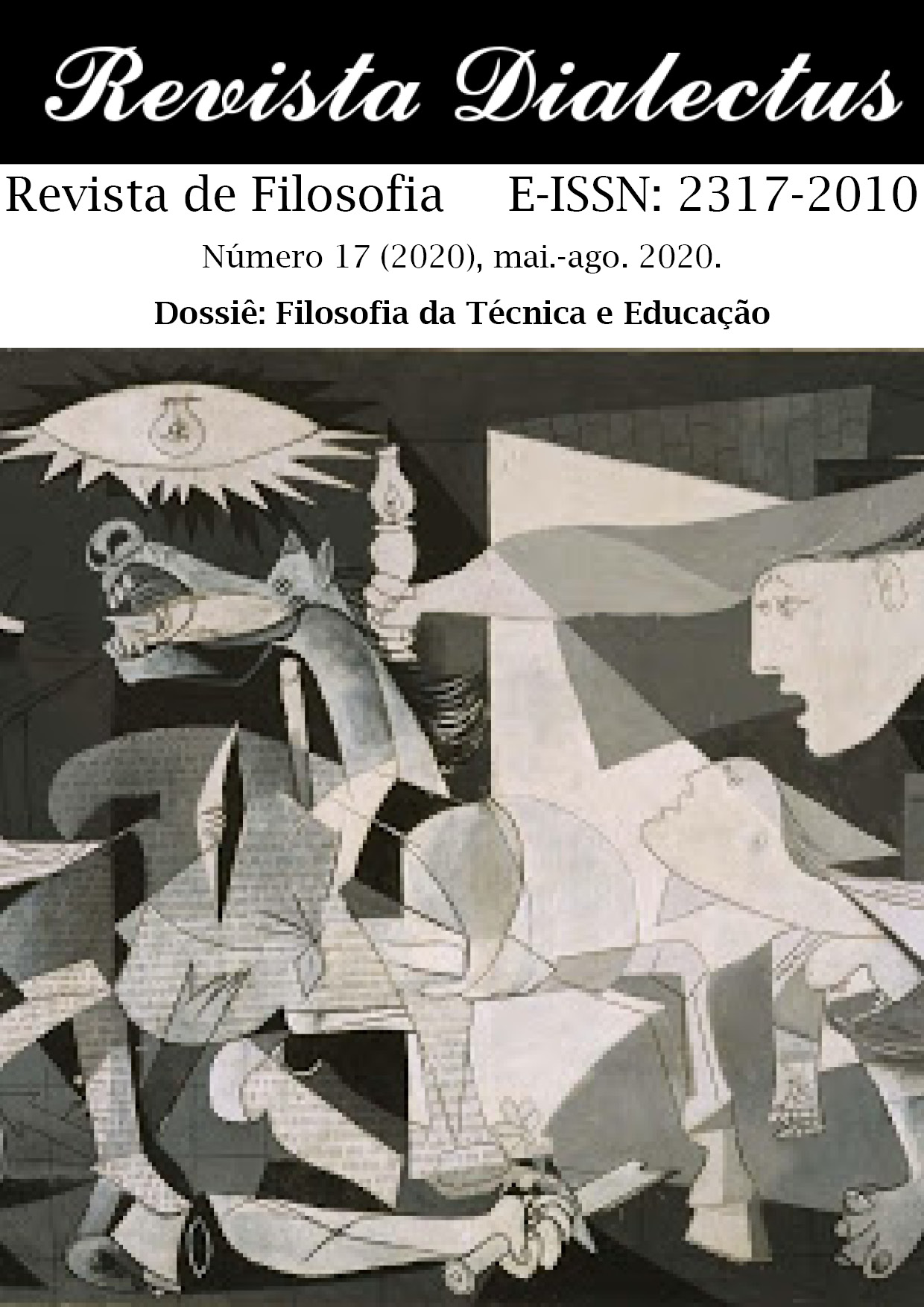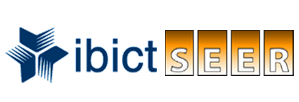A PEDAGOGIA NO ESPAÇO CIBERNÉTICO: A DINÂMICA DO DISCURSO ONLINE
DOI:
https://doi.org/10.30611/2020n17id60615Keywords:
Discurso online, Espaço cibernético, PedagogiaAbstract
O artigo elabora um modelo para a compreensão da pedagogia no ambiente dos fóruns educacionais online. O modelo identifica quatro componentes. Primeiro, o engajamento intelectual é o componente que revela os processos cognitivos de primeiro plano do aprendizado colaborativo. Em segundo lugar, os processos de comunicação que operam no plano de fundo são aqueles que acumulam um depósito ainda mais rico de conhecimentos compartilhados que possibilitam o avanço da conversação. Em terceiro lugar, o processo colaborativo é o componente que requer um moderador para coordenar a comunicação e o aprendizado em grupo. O moderador na educação online é geralmente um professor que compartilha o conhecimento no processo de liderar a discussão. Em quarto e último lugar, a discussão bem sucedida gera motivações intrínsecas para a participação, as quais mantêm a discussão em andamento. Tal estrutura foi projetada para mostrar a complexidade da discussão online e fornecer uma base que sirva para orientar professores e avaliar aplicativos e softwares.
References
BERGE, Z. L. (1995). Facilitating computer conferencing: Recommendations from the field. Educational Technology, vol. 15, n. 1, pp. 22 30.
BRUFFEE, K. A. (1999). Collaborative learning: Higher education, interdependence, and the authority of knowledge (2ª ed.). Baltimore, MD: Johns Hopkins University Press.
BURBULES, N. C. (1993). Dialogue in teaching: Theory and practice. New York, NY: Teachers College Press.
CLARK, H.; SCHAEFER, E. F. (1989). Contributing to discourse. Cognitive Science, vol. 13, n. 2, pp. 259 294. Disponível em: https://onlinelibrary.wiley.com/doi/pdf/10.1207/s15516709cog1302_7.
DEWEY, J. (1938). Experience and education. New York, NY: Touchstone.
FEENBERG, A. (1989). The written world. In: MASON, R.; KAYE, A. (Eds.). Mindweave: Communication, computers, and distance education. Oxford, UK: Pergamon Press, pp. 22 39.
FEENBERG, A. (2000). Online pedagogy with discussion management software. Texto apresentado na American Association of University Professors Annual Meeting, Washington, DC.
FEENBERG, A.; XIN, M. C. (2002). A teacher’s guide to moderating online discussion forums: From theory to practice. [S. l.: s. n.].
FEENBERG, A.; XIN, M. (2003). Facilitation. In: DISTEFANO, A. RUDESTARN, K. E.; SILVERMAN, R. (Eds.). Encyclopedia of distributed learning. Thousand Oaks, CA: SAGE Publications.
GADAMER, G. (1982). Truth and method. New York, NY: Crossroads.
GARRISON, D. R. (1991). Critical thinking and adult education: A conceptual model for developing critical thinking in adult learners. International Journal of Lifelong Education, vol. 10, n. 4, pp. 287 303.
GARRISON, D. R.; ANDERSON, T.; ARCHER, W. (2001). Critical thinking, cognitive presence, and computer conferencing in distance education. American Journal of Distance Education, vol. 15, n. 1, pp. 7 23.
GARRISON, D. R.; ARCHER, W. (2000). A transaction perspective on teaching and learning: A framework for adult and higher education. Amsterdam: Pergamon.
GOFFMAN, E. (1961). Encounters. New York, NY: Bobbs Merrill.
GOODWIN, C.; HERITAGE, J. (1990). Conversation analysis. Annual Review of Anthropology, vol. 19, pp. 283 307. Disponível em: https://www.annualreviews.org/doi/pdf/10.1146/annurev.an.19.100190.001435.
GUNAWARDENA, C. N. (1995). Social presence theory and implications for interaction and collaborative learning in computer conferences. Hsinchu, Taiwan. Texto apresentado na Fourth International Conference on Computer Assisted Instruction.
GUNAWARDENA, C. N.; ZITTLE, F. (1997). Social presence as a predictor of satisfaction within a computer mediated conferencing environment. American Journal of Distance Education, vol. 11, n. 3, pp. 8 26.
GUNAWARDENA, C. N.; LOWE, C. A.; ANDERSON, T. (1997). Analysis of a global online debate and the development of an interaction analysis model for examining social construction of knowledge in computer conferencing. Journal of Educational Computing Research, vol. 17, pp. 395 429.
HAMILTON, E.; FEENBERG, A. (no prelo). The technical codes of online education. Techné. Posteriormente publicado em: Techné, vol. 9, n. 1, pp. 97 123, outono de 2005 (N. do T.). Disponível em: https://www.sfu.ca/~andrewf/books/hamilton_feenberg_techne.pdf.
HERRING, S. (1996). Computer mediated communication: Linguistic, social and cross
cultural perspectives. Pragmatics and Beyond Series. Amsterdam: John Benjamin.
HERRING, S. (1999). Interactional coherence in CMC. Journal of Computer Mediated Communication, vol. 4, n. 4. Disponível em: https://onlinelibrary.wiley.com/doi/full/10.1111/j.1083 6101.1999.tb00106.x.
HILTZ, S. R.; TUROFF, M. (1978). The network nation: Human communication via computer. Cambridge, MA: MIT Press.
HUTCHINS, E. (1991). The social organization of distributed cognition. In: RESNICK, L. S.; LEVINE, J. M.; TEASLEY, S. D. (Eds.). Perspectives on socially shared cognition. Washington, DC: American Psychology Association, pp. 283 307.
KANUKA, H. (2005). An exploration into facilitating higher levels of learning in a text based internet learning environment using diverse instructional strategies. Journal of Computer
Mediated Communication, vol. 10, n. 3. Disponível em: https://onlinelibrary.wiley.com/doi/full/10.1111/j.1083 6101.2005.tb00256.x.
KANUKA, H.; KREBER, C. (1999). Knowledge construction in the virtual classroom. Texto apresentado na 18th National Conference of the Canadian Association for the Study of Adult Education, Sherbrooke.
KITCHER, P. (1993). The advancement of science. New York, NY: Oxford University Press.
KOZULIN, A. (2003). Psychological tools and mediated learning. In: KOZULIN, A.; GINDIS, B.; AGEYEV, V. S.; MILLER, S. M. (Eds.). Vygotsky’s educational theory in cultural context. New York, NY: Cambridge University Press, pp. 15 38.
LEVINSON, S.C. (1983). Pragmatics. New York, NY: Cambridge University Press.
LIPMAN, M. (1991). Thinking in education. Cambridge, UK: Cambridge University Press.
LYNCH, M. (1993). Scientific practice and ordinary action. Cambridge, UK: Cambridge University Press.
MAZUR, J. (2003). Conversation analysis for educational technologists: Theoretical and methodological issues for researching the structures, processes, and meaning of on line talk. In: JONASSEN, D. H. (Ed.). Handbook of research for educational communications and technology: A project of the Association for Educational Communications and Technology. Mahwah, NJ: Erlbaum, pp. 1073 1098.
MERRILL, D. (1992). Constructivism and instructional design. In: DUFFY, T. M.; JONASSEN, D. H. (Eds.). Constructivism and the technology of instruction. Mahwah, NJ: Erlbaum, pp. 99 114.
NEWMAN, D. R.; JOHNSON, C.; COCHRANE, C.; WEBB, B. (1997). Evaluating the quality of learning in computer supported co operative learning. Journal of American Society for Information Science, vol. 48, n. 6, pp. 484 495.
OATLEY, K. (1991). Distributed cognition. In: EYSENCK, H.; ELLIS, A.; HUNT, E.; JOHNSON LAIRD, P. (Eds.). The Blackwell dictionary of cognitive psychology. Oxford, UK: Blackwell, pp. 102 107.
PEA, R. (1993). Practices of distributed intelligence and designs for education. In: SALOMON, G. (Ed.). Distributed cognitions: Psychological and educational considerations. Cambridge, UK: Cambridge University Press, pp. 47 87.
ROURKE, L. (2000). Operationalizing social presence in asynchronous, text based computer conferencing. Texto apresentado na Canadian Association of Distance Education (CADE) annual conference, Quebec City.
ROURKE, L.; ANDERSON, T. GARRISON, D. R.; ARCHER, W. (1999). Assessing social presence in asynchronous, text based computer conferencing. Journal of Distance Education, vol. 14, n. 2, pp. 51 70. Disponível em: https://auspace.athabascau.ca/handle/2149/732.
ROSCHELLE, J. (1996). Learning by collaborating: Convergent conceptual change. In: KOSCHMANN, N. J. M. T. (Ed.). CSCL: Theory and practice of an emerging paradigm. Mahwah, NJ: Erlbaum, pp. 209 248
ROSSMAN, M. (1999). Successful online teaching using an asynchronous learner discussion forum. Journal of Asynchronous Learning Networks, vol. 3, n. 2.
STALNAKER, R. C. (1978). Assertion. In: COLE, P. (Ed.). Syntax and semantics: Pragmatics. New York, NY: Academic Press, vol. 9, pp. 315 332.
VYGOTSKY, L. S. (1962). Thought and language. Cambridge, MA: MIT Press.
VYGOTSKY, L. S. (1978). Mind in society: The development of higher psychological processes. Cambridge, MA: Harvard University Press.
WOOD, D. (1999). Teaching the young child: Some relationships between social interaction, language and thought. In: LLOYD, P.; FERNYHOUGH, C. (Eds.). Lev Vygotsky: Critical assessments. London: Routledge, vol. 3, pp. 259 275.
XIN, M. C. (2002). Validity centered design for the domain of engaged collaborative discourse in computer conferencing. Tese (de Doutorado). Provo, UT: Brigham Young University.
XIN, M. C.; FEENBERG, A. (2002). Designing for pedagogical effectiveness: TextWeaver. Texto apresentado na Hawaii International Conference of System Sciences, IEEE.
Downloads
Published
Issue
Section
License
Authors who publish in this journal agree to the following terms:
- Authors retain the copyright and grant the journal the right of first publication, with the work simultaneously licensed under the Attribution-NonCommercial-NoDerivatives 4.0 International (CC BY-NC-ND 4.0) License, which allows the non-commercial sharing of work, without modifications and with acknowledgment of authorship and initial publication in this journal.
- Authors are authorized to take additional contracts separately, for non-exclusive distribution of the version of the work published in this journal (eg publish in institutional repository or as a book chapter), with acknowledgment of authorship and initial publication in this journal.
- Authors are allowed and encouraged to publish and distribute their work online (eg in institutional repositories or on their personal page) at any point before or during the editorial process, as this can generate productive changes as well as increase the impact and citation of published work (See The Free Access Effect).



















